- Event
- Film Screening
The Beat Hotel
Fri, July 20, 2012 6:00 pm CEST
- Location
- Lecture Hall
“The Beat Hotel,” a new film by Alan Govenar, goes deep into the legacy of the American Beats in Paris during the heady years between 1957 and 1963, when Allen Ginsberg, Peter Orlovsky and Gregory Corso fled the obscenity trials in the United States surrounding the publication of Ginsberg’s poem “Howl.” They took refuge in a cheap no-name hotel they had heard about at 9, Rue Git le Cœur and were soon joined by William Burroughs, Ian Somerville, Brion Gysin, and others from England and elsewhere in Europe, seeking out the “freedom” that the Latin Quarter of Paris might provide.
“The Beat Hotel,” as it came to be called, was a sanctuary of creativity, but was also, as British photographer Harold Chapman recalls, “an entire community of complete oddballs, bizarre, strange people, poets, writers, artists, musicians, pimps, prostitutes, policemen, and everybody you could imagine.” And in this environment, Burroughs finished his controversial book “Naked Lunch;” Ian Somerville and Brion Gysin invented the “Dream Machine;” Corso wrote some of his greatest poems; and Harold Norse, in his own cut-up experiments, wrote the novella, aptly called “The Beat Hotel.”
The film tracks down Harold Chapman in the small seaside town of Deal in Kent England. Chapman’s photographs are iconic of a time and place when Ginsberg, Orlovsky, Corso, Burroughs, Gysin, Somerville and Norse were just beginning to establish themselves on the international scene. Chapman lived in the attic of the hotel, and according to Ginsberg “didn’t say a word for two years” because he wanted to be “invisible” and to document the scene as it actually happened.
In the film, Chapman’s photographs and stylized dramatic recreations of his stories meld with the recollections of Elliot Rudie, a Scottish artist, whose drawings of his time in the hotel offer a poignant and sometimes humorous counterpoint. The memories of Chapman and Rudie interweave with the insights of French artist Jean-Jacques Lebel, author Barry Miles, Danish filmmaker Lars Movin, and the first hand accounts of Oliver Harris, Regina Weinrich, Patrick Amie, Eddie Woods, and 95 year old George Whitman, among others, to evoke a portrait of Ginsberg, Burroughs, Corso and the oddities of the Beat Hotel that is at once unexpected and revealing.
The “Beat Hotel” is completed, and is distributed by First Run Features. The world premiere was presented by the Danish Film Institute in Copenhagen in December 2011.
Previously two guided tours with curators "William S. Burroughs between Cut-Up and Collage" (Axel Heil) and "the name is BURROUGHS: from Mexico City to Tanger − from Beat Hotel to Lawrence, Kansas" (Udo Breger) will be offered at 4 p.m.
“The Beat Hotel,” as it came to be called, was a sanctuary of creativity, but was also, as British photographer Harold Chapman recalls, “an entire community of complete oddballs, bizarre, strange people, poets, writers, artists, musicians, pimps, prostitutes, policemen, and everybody you could imagine.” And in this environment, Burroughs finished his controversial book “Naked Lunch;” Ian Somerville and Brion Gysin invented the “Dream Machine;” Corso wrote some of his greatest poems; and Harold Norse, in his own cut-up experiments, wrote the novella, aptly called “The Beat Hotel.”
The film tracks down Harold Chapman in the small seaside town of Deal in Kent England. Chapman’s photographs are iconic of a time and place when Ginsberg, Orlovsky, Corso, Burroughs, Gysin, Somerville and Norse were just beginning to establish themselves on the international scene. Chapman lived in the attic of the hotel, and according to Ginsberg “didn’t say a word for two years” because he wanted to be “invisible” and to document the scene as it actually happened.
In the film, Chapman’s photographs and stylized dramatic recreations of his stories meld with the recollections of Elliot Rudie, a Scottish artist, whose drawings of his time in the hotel offer a poignant and sometimes humorous counterpoint. The memories of Chapman and Rudie interweave with the insights of French artist Jean-Jacques Lebel, author Barry Miles, Danish filmmaker Lars Movin, and the first hand accounts of Oliver Harris, Regina Weinrich, Patrick Amie, Eddie Woods, and 95 year old George Whitman, among others, to evoke a portrait of Ginsberg, Burroughs, Corso and the oddities of the Beat Hotel that is at once unexpected and revealing.
The “Beat Hotel” is completed, and is distributed by First Run Features. The world premiere was presented by the Danish Film Institute in Copenhagen in December 2011.
Previously two guided tours with curators "William S. Burroughs between Cut-Up and Collage" (Axel Heil) and "the name is BURROUGHS: from Mexico City to Tanger − from Beat Hotel to Lawrence, Kansas" (Udo Breger) will be offered at 4 p.m.
Event Website
Organizing Organization / Institution
ZKM
This Event - Is part of
Accompanying program
Accompanying Program
